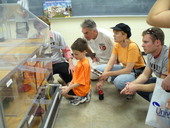Highlight
IGERT Trainees Continue to Reach Out and to Educate and Inspire Others
Achievement/Results
For the fifth straight year, trainees and affiliates of the National Science Foundation’s (NSF) Integrative Graduate Education and Research Traineeship (IGERT) program in Indoor Environmental Science and Engineering at The University of Texas (UT) have been actively involved in a wide range of public outreach efforts. Outreach activities are an important part of professional development in our IGERT program. These activities provide a service to community, and allow our students to hone their public communication and interdisciplinary teamwork skills. In the past year our students logged 400 to 500 student-hours of community service, and have approached or surpassed 2,500 student-hours for our IGERT lifetime. Several examples are provided here.
In March of 2011, six IGERT trainees and affiliates and IGERT faculty participant Atila Novoselac spent 5+ hours presenting demonstrations to 200+ members of the public on airflows in homes, indoor chemistry, energy efficient lighting, and thermal imaging. This is an annual event for our IGERT program and takes place at Explore UT, a large open house weekend on the University of Texas campus. At a similar event in December 2010, as part of a monthly evening science series at UT, trainees completed hands-on demonstrations related to indoor air quality to over 500 members of the general public. In June 2010, five IGERT trainees and IGERT faculty participant Richard Corsi presented hands-on demonstrations related to indoor air quality and energy conservation to 100 minority high school students as part of UT’s My Introduction to Engineering (MITE) program. These demonstrations involve applications of the House of Pressure, a scaled-down plastic house that can be used to demonstrate air flow patterns and pollutant sources and transport in homes, an infrared imaging system to demonstrate to attendees heat loss from their bodies and buoyant plumes that affect air flow around their breathing zones and room, a thermal manikin to demonstrate air flow patterns around the human body, the rapid formation of secondary organic nanoparticles from ozone reactions with common terpenoids in consumer products, and particle emissions from paraffin, soy and beeswax candles.
Trainees of the IGERT program on Indoor Environmental Science and Engineering also served as judges at elementary and middle school science fairs, organized career events for the UT Women in Engineering Program, mentored 10 undergraduate students, discussed indoor air quality with middle school students at the Ann Richards School for Young Female Leaders, developed a board game related to indoor air quality and used it with classes at a local middle school, developed brochures to educate residents about how to keep their homes healthy after weatherization, developed five public service announcements on indoor air quality that have been posted on YouTube, and more.
Address Goals
The aforementioned outreach activities go to the heart of learning, not just for the public that receives information from our IGERT trainees and affiliates, but also for our IGERT students themselves. Students necessarily learn how to “boil down” complex subjects in such a way that the general public can understand. In doing so, our IGERT trainees and affiliates employ state-of-the-art demonstrations of pollutant emissions, air flow in buildings, the effects of human beings on indoor air flow through analysis of buoyant plumes, and indoor chemistry. They also help to inspire bright young minds such as those high school students who participate in My Introduction to Engineering and middle school girls at the Anne Richard’s School for Young Female Leaders. While there is not a true intellectual discovery component to these activities, it is clear that our trainees and affiliates engage in discovery relative the joy of teaching others about scientific principles applied to indoor environments.






